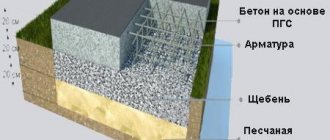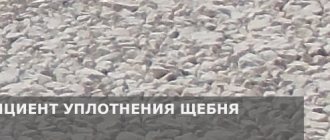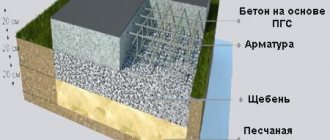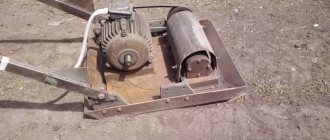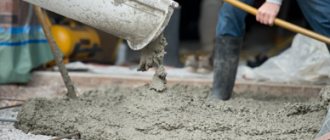When constructing foundations, blind areas, bases for paths and roads, sidewalks and laying communications, various combinations of soil, sand, crushed stone, gravel and secondary gravel are used. In this case, the mixtures are necessarily compacted and compacted, which implies a certain compaction coefficient, which must be known to accurately calculate the material.
Typical preparation of the base for a monolithic or block foundation in section
On average, data on the compaction coefficients of the most popular materials is presented in Table 1.
| Material and its technical characteristics | Compaction factor |
| Crushed stone fraction 40-70, grade 800 fraction 70-120, grade 800 all fractions, grade 300…600 | Average 1.1 1,25…1,3 1,25…1,3 1,1…1,5 |
| Slag, depending on density | 1,3…1,5 |
| Construction sand | 1,15 |
| Soil, depending on type | 1,1…1,4 |
| PGS | 1,2 |
| Expanded clay | 1,15 |
However, these are general, average data. Let's take a closer look at where the concept of compaction coefficient comes from and how to determine it.
Materials used
For different types of foundations, it can use both local compacted soil and imported materials. Most often, local semi-rocky and sandy soils are subjected to compaction. Already loams, and even more so clayey soils, must be removed to the depth of the pit and replaced with a cushion of sand and gravel.
In this case, the base layers must be subjected to compaction, the effectiveness of which depends on the following factors:
- layer material. For crushed stone of different types, gravel, gravel-sand mixture (GSM) and sand, the compaction coefficient is very different;
- fractions of material. The larger the fragments, the more difficult it is to compact them;
- tamping method - manual, mechanized - and the force applied;
- height and total volume of the backfilled layer;
- the presence of material with a grain size less than that specified by the lower limit of this class (for example, for crushed stone of fraction 5...20, the content of stone up to 3 mm in size inclusive is about 5% - such a discrepancy will have little effect on the degree of compaction. If the percentage is ¼...1/4 volume – adjustments will have to be made);
- flakiness (for crushed stone). This parameter expresses the ratio of the content of cuboidal stones to flat ones. The lower the flakiness, the more cubic elements and the more densely the crushed stone can be compacted;
- layer moisture.
Quality standards, fractions and other parameters of crushed stone are regulated by GOST 8267-93 for crushed stone and GOST 8736-2014 for construction sand.
Accordingly, the degree of compaction of any bulk material, expressed by a dimensionless coefficient, depends on the type of material and operating conditions.
ShchPS in construction
Crushed stone-sand mixtures are widely used in almost all areas of construction; they are actively used in road repair work, when laying highways, railways, and tram tracks. The specific scope of use depends on the fraction of crushed stone in the mixture. According to these indicators, the ShchPS are divided into several groups: C2, C3, C4, C5.
ShchPS of groups C2, C3 with crushed stone of small fractions are used mainly in foundation work. Granite crushed stone has high strength and frost resistance, so the use of ACH in mortars makes it possible to increase the strength of the structures being created, their durability and resistance to loads. In the production of concrete panels and slabs, ACHPS of groups C3, C4 with crushed stone of larger fractions of 20-40 mm are used. They are also used when laying a ballast layer for railway and tram rails, and filling roadsides.
What is transportation compaction factor
This name refers to the ratio of the volume of material at the time of loading the vehicle to the volume at the time of delivery.
Taking into account the fact that during transportation bulk material is inevitably compacted - road shaking plays the role of compaction - the minimum acceptable coefficient for accepting crushed stone, sand or sand-gravel mixture delivered to the site is considered to be 1.1. That is, data on the volume of the body (car, other transport capacity), multiplied by a factor of 1.1, must match the ordered volume or slightly exceed it. If the resulting figure is less than the required one by 2...5% or more, it is necessary to resolve the issue of shortage of material.
Example.
20 cubic meters of crushed stone were ordered, 18 cubic meters were delivered. (according to measurements from the inside of the body). Taking into account the coefficient 18x1.1=19.8 cubic meters. The underload is 0.2 cubic meters, that is, 1% - the error is within the permissible limit.
Important: data on the compaction of the material during transportation may be indicated, but is not required to be indicated in the accompanying documents of the cargo! To avoid misunderstandings, ask the supplier to include the data in the sales and transportation agreement.
ShchPS in road works
Crushed stone-sand mixtures are also actively used in road construction; S3-S6 ShchPS are in demand in this area. Mixtures with coarse crushed stone in the C5, C6 groups are used to create the bottom layer of road bases; they ensure the stability of the road surface under the influence of loads and prevent the appearance of cracks on its surface. C3 and C4 are used in asphalt and coatings. C 6 is used in the construction of massive concrete structures, platforms for heavy vehicles, and the creation of airfield runways.
The qualitative characteristics of schlyparticles include an unlimited shelf life, the mixtures can be stored even in the open air in the immediate vicinity of the work site, over time they will not lose their qualities, it is a completely ready-to-use material that does not require the use of mixing plants in the process of creating road grounds. Purchasing a crushed stone-sand mixture is more profitable than purchasing two components of the mixture and mixing them yourself in the required proportions.
How is the compaction factor calculated?
This requires laboratory or, for private housing construction, home tests.
A sample of material is compacted to the extent that will be organized on the construction site, after which measurements of the compacted sample are compared with measurements before compaction.
The general principles of testing, the equipment and methods used are described in GOST 22733-2016 and GOST 8269.0-97.
For a more complete understanding of the process of checking the degree of compaction of bulk materials, we recommend watching the video.
You can also use more accurate soil density meters.
Advantages of using crushed stone-sand mixtures
Crushed stone-sand mixtures are popular in construction due to a set of valuable characteristics, including:
- Low cost, since ALP is a by-product of crushed stone mining.
- Easy to transport - can be transported in any cargo transport.
- Infinite shelf life and unpretentious storage conditions.
To increase the degree of compaction and prevent too high moisture content, ACHPS is treated with liquid stabilizers - soluble emulsions based on sulfonated oil, organic materials containing protein or sulfuric and buffer acids. Stabilizers reduce swelling, shrinkage, dust formation, and the thickness of structural layers. They increase the density of the material, load-bearing capacity, and water resistance.
Crushed stone compaction coefficient
According to SNiP 3.06.03-85, the normal compaction coefficients for crushed stone are:
- 1.25...1.3 for grade 800, fractions 40-70 and 70-120;
- 1.1…1.5 for grades 300…600, depending on the fraction;
- 1.3…1.5 for slag depending on its density.
At the same time, it is impossible to obtain accurate data; even the supplier provides information on the degree of compaction with a certain tolerance.
If there is no reliable information, but it is necessary to ensure increased compaction density, SNiP recommends using wedging (that is, wedging in smaller stones):
- for fraction 40-70 crushed stone fractions 5-20, 0-20, 0-10 - gradually, with a decrease in fraction towards the surface of the layer;
- for fraction 70-120 – crushed stone 40-70.
In this case, the consumption of smaller stones should correspond to the data in the table below.
To facilitate wedging and better compaction, the mixture is spilled with water during the compaction process, at a flow rate of 15...25 / sq. m. If slag is used, the amount of water increases to 25...35 l/sq.m. at the primary stage and 10...12 l/sq.m. at the decluttering stage.
Classification of crushed stone-gravel-sand mixtures by grain composition
The areas of application of AHP largely depend on the grain composition. In accordance with this parameter, they are divided into several groups.
Coating materials:
- C1.
The largest fraction present in this mixture is 40 mm. Its amount does not exceed 10%. The main area of application is the construction of coatings that must have a perfectly smooth surface, for example, airfield landing strips. - C2.
The maximum grain size is 20 mm. The composition includes crushed stone with high frost resistance. The material is used for creating road surfaces of categories I-III, constructing landing strips, and landscaping in private areas. The coating obtained using ShchPS C2 is resistant to water, mechanical loads, and temperature changes.
Substrate mixtures (continuous granulometry):
- C3.
The maximum grain size is 120 mm. The main purpose of using this material is to create additional layers of the road base. The use of ShchPS S3 allows you to save concrete and asphalt concrete. - C4.
The largest grain size is 80 mm. The content of the coarse fraction should not exceed 10%. Material containing crushed stone with a radiation index of no more than 300 Bq/kg can be used in residential construction. It is also in demand when constructing roads, strengthening roadsides, and creating ballast prisms for tram and railway tracks. - C5.
The maximum grain size is 40 mm. The mixture is used in the construction of residential and industrial buildings, construction of roads, and for strengthening roadsides. - C6.
The largest fraction is 20 mm. It is used in almost all areas of residential, industrial, and road construction. - C7 and C8.
These fine-grained materials are used to create the bottom layer of roads.
Base materials (discontinuous granulometry):
- C9.
The coarse mixture contains large granules up to 80 mm. It is used in the construction of roads, parking lots, squares, and strengthening roadsides. - C10.
The maximum grain size is 40 mm. This bulk material is in demand at the initial stage of road construction. - C11.
The largest fraction is 20 mm. The main area of application is road construction.
Sand compaction coefficient
Here you can also rely on the supplier’s data, but it is better to check real data using test results.
The average bulk density of sand is indicated in the table.
Based on regulatory data, the average compaction coefficient of construction sand is assumed to be 1.15.
It should be remembered that for some types of work, thorough sand compaction may not be necessary, and accordingly the coefficient may be less than one.
The process of laying rubble stone
Working with natural stone begins with preliminary preparation: sorting by size and color, cleaning from traces of soil, organic inclusions, and construction waste. Then the stone needs to be soaked in water so that it is saturated with moisture and does not pull it out of the cement mortar.
To ensure that the adhesion of the rubble masonry to the concrete of the foundation or plinth is as strong as possible, the first row of stone should be laid 4 hours after pouring. After the concrete has set, masonry can be done using the usual method.
Structures made of rubble stone can last for more than a hundred years if you select the appropriate rock and follow the installation technology
A neat and attractive look to a rubble wall will be given by jointing, which must be done after the mortar has set. When making a mortar for rubble stone from granite, take two parts of sand to one part of cement (M400 or M500). For limestone or sandstone the proportion is 1:3.
The gaps between the stones must be filled very carefully so that there are no voids or holes where snow or water can get in.
ASG compaction coefficient
Sand-gravel mixture (SGS) is a natural or enriched (OPGS) mixture of sand and gravel. The composition of the natural mixture is standardized by GOST 23735-2014; according to GOST, the content of gravel grains with a fraction of about 5 mm should be within 10...90%.
This material is rarely used for filling a sand and gravel cushion under the foundation; it is more often used for the production of medium and heavy concrete. Accordingly, the grain size and percentage composition of the mixture greatly influence the compaction coefficient of concrete.
The ASG group must be taken into account according to the table.
ShchPS: composition, types, characteristics, applications
- Classification of ALP by grain composition
- Main characteristics of crushed stone-sand mixtures
- Areas of application of ShchPS
- Benefits of using ShchPS
Crushed stone-sand mixture (SCS) is a complex building material of natural origin, which is a by-product of mining and processing of rocks. A mixture of crushed stone, gravel, and sand is delivered to special processing plants. There it is crushed, cleared of debris, and sorted. The production of these products is characterized by simplicity and the absence of complex expensive equipment, which ensures their low cost. The qualitative characteristics of ShchPS, widely used in the construction of highways and airfields, are regulated by GOST 25607-2009.
Advantages and disadvantages
The number of advantages of rubble stone is impressive. It is not for nothing that it is still one of the popular building materials. Among its advantages:
- Environmental friendliness. Due to its natural origin, rubble stone is harmless to health, which adds to its popularity.
- Significant wear resistance. Mold, insects, humidity, temperature changes, and wind are not harmful to rubble stone and do not deteriorate its qualities. It withstands vertical and horizontal loads well.
- Easy to make. To obtain rubble stone, no complex technologies or equipment are required. And this has a good effect on its price.
- Long service life. Buildings made of rubble stone can last more than a hundred years.
- Aesthetic appearance. Rubble stone is not only reliable, it looks great in decorative compositions.
With skillful hands, rubble stone compositions can easily turn into works of art
This building material also has disadvantages. The main one is the complexity of use. In order to beautifully lay rubble stone and select pieces that fit together, considerable skill is required. But everything comes with experience. Having accumulated it, you can completely transform your summer cottage, with your own hands and at low cost.
The main task is to select stones that are suitable in shape and size.
